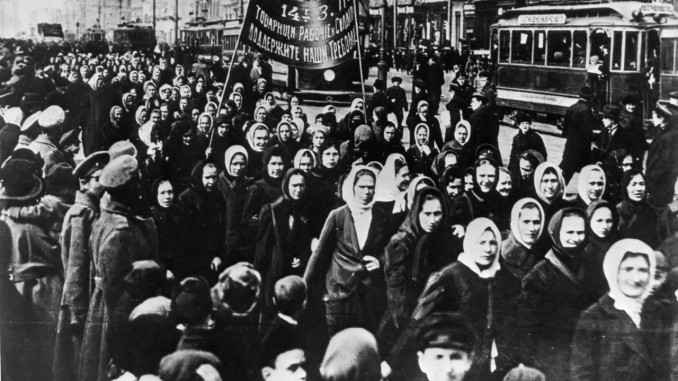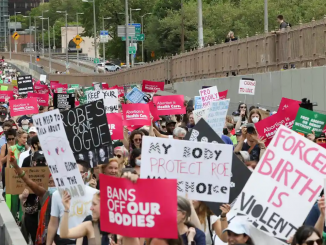
It was over 100 years ago that women in Russia achieved full abortion rights, communal kitchens, free childcare, equal pay, and the right to love, marry and divorce as their hearts pleased. Looking back, it is hard to believe that those gains would be achieved in a matter of months in a country where women lived for centuries in conditions of utter brutality and poverty. It appears even more unlikely in the face of the attacks we confront today in the U.S. and across the world, despite the years of struggle by the women’s movement. This episode in history raises the question: what lessons can we draw from the fight in 1917, which achieved what we have not?
Here we republish an excerpt from our pamphlet on the Russian Revolution focused on what it meant for women.
Women Before the Revolution
Gathering together in meetings and conferences, women old and young, from the fields and the factories, questioned life as it was and began reorganizing social life to suit their own needs. It’s hard to believe that the first country in the world to legalize abortion did so 98 years ago, in a land where 80 percent of the people were peasants raised in a culture of extreme disdain for women, in conditions of terrible poverty, and on the background of a brutal war. A census shows that in 1907, only 17% of Russian women were literate. For men the percentage was 45%. The traditional oppression of women was so extreme that Russian marriage ceremonies at the time included the bride giving her husband a whip, sometimes braided by her own hands, sometimes passed from her father to her husband, with which the groom stroked the bride’s shoulders to symbolize her total submission to him.
In the countryside, peasant women, by far the majority, did the brutal work of the farm together with the men. Along with plowing the fields and harvesting the crops, they were charged with tending the vegetable plots the family depended on, sowing and mending the clothes, cooking the meals, turning milk into butter and cheese, canning, and all this, of course, in addition to bearing and caring for children. It was a culture of obedience to the Tsar, to God, the Eastern Orthodox Church, and more immediately, to fathers and husbands.
The development of industry in the late 1800s and early 1900s transformed the lives of millions of peasant women as their families were drawn to the cities by industrial jobs. Factory owners pulled women into the industrial workplaces by the tens of thousands, happy to have laborers that were considered docile and compliant, resulting in more work for less pay. But this docility and compliance were traits that the social struggles of the late 1800s and the early 1900s would alter. From the late 1800s, through the failed revolution of 1905, and to the beginning of World War I, there were waves of conflict in the cities: strikes and protests against brutal conditions that transformed many of these women. These were fights that created a culture of organizing and solidarity among the working class.
To add to the brutality of the world of work, by 1917, urban as well as peasant women found themselves profoundly impacted by World War I. Many were alone with their children, as their brothers and husbands were conscripted in the war. Women went days without eating at times, and spent hours waiting in line for food.
The February Revolution
How did the February Revolution of 1917 begin? January and February were marked by strikes in Petrograd, but on International Women’s Day, March 8, 1917 (February 23 by the old Russian calendar), the working women in an industrial district of Petrograd left their factories to fight for an increase in their rations to feed their families. They poured out into the streets, and marched through their neighborhood and other working-class districts nearby. As they marched they called on others to join them, and attracted thousands onto the streets. Later that day and the next there were confrontations with the police, soldiers, and Cossacks. Women organized “flying pickets,” groups of women who went to defend the demonstrations; when they were attacked they convinced the soldiers and Cossacks to hold their fire and swords. His power having crumbled, the Tsar fled the city. This strike of the women was the fight that set the February Revolution into motion, launching Russia into its first experiment with democratic rule. Though it eliminated the Tsar, it did not eliminate the power of the factory owners and landowners, nor their alliance with the international capitalist – their allies in the World War – and so the conditions of the women were not transformed either. The oppression and the hunger continued.
The Revolution: A New World for Women
The position of women in society changed dramatically in October when the soviets, the Russian name for the councils of workers, peasants and soldiers, seized the power from the Provisional Government established in February. The new workers’ state gave women the opportunity to make changes that would be enviable in our place and time.
Just as the October Revolution was taking place, the First All-City Conference of Petrograd Working Women was being held. The conference was attended by 500 delegates, elected by 80,000 working women, organized by the Bolshevik women’s journal Rabotnitsa (The Woman Worker, started in 1914). Their goal was to prepare women who were not in the Bolshevik Party to think about women’s welfare and the program that could be implemented by the workers’ state. Of course, the conference was suspended while the delegates joined the armed uprising. Women dug entrenchments, bore arms, stood guard, and nursed the wounded.
Immediately after the workers seized power in the October Revolution, the Bolshevik Party (renamed the Communist Party in 1918) introduced a series of laws that gave women new rights. The Revolution abolished the inferior legal status of women and imposed equality in the workplace for the first time, with equal wages for equal work. The Family Code of 1918 established civil, non-religious marriages, and gave men and women the right to a divorce on demand, initiated by either partner. Illegitimacy was abolished, so that both men and women would both be responsible for all of their children. Women benefited from the introduction of the 8-hour day, but at work new rules also forbade pregnant women working overtime and at night. For nursing women, a 30-minute breast-feeding break was required every three hours. The Soviet government created a paid maternity leave program, allowing working mothers eight weeks paid leave and other benefits. In addition, it created the Matmlad, a department “for the Protection of Mothers and Infants.” This department provided maternity clinics, daycares and homes for single mothers in Russian cities and large towns.
In 1920, the Family Code was updated; abortion was legalized and made free on demand. Can we imagine such a thing in the United States in 2017? As to sexuality, the Revolution eliminated all references to sexual practices in the Criminal Code in 1922. After this date the only kind of sex crime was one that violated the individual’s right to “life, health, freedom and dignity.” There was even a court case that confirmed the right of two women to marry!
The organization that sought to transform the lives of women was the Zhenotdel, the women’s section of the Central Committee of the Communist Party. In the fledgling workers’ state, the Zhenotdel became the first Government Department ever to be established to care for the welfare of women. Its first leader, Alexandra Kollontai, a member of the Russian Social Democratic Labor Party since 1899 and a Bolshevik since 1904, had long written about her notion of free love: a relationship between men and women that was completely liberated from any kind of social or economic compulsion. She believed society needed a revolution in attitudes toward sexuality. She and the other leaders of the Zhenotdel, the Bolshevik leaders Inessa Armand and Konkordiia Samoilova, imagined the end of marriage, to be replaced by free unions, and even the end of the family itself with communal childcare, nurseries, restaurants, laundries: all traditional women’s work being carried out communally with individuals paid for their work. From these ideas followed experimentation. Rather than convincing men to share the drudgery of housework, the feminists of the day thought that paid labor in a communal setting was the answer. Communal nurseries, laundries and dining rooms were established. Our modern models of co-housing had a precedent in Soviet architects’ designs for new homes that took into account plans for communal facilities. The Zhenotdel was the power-house of action that encouraged women and men to re-think their social lives.
The volunteers from the Zhenotdel traveled throughout Russia to spread their revolutionary ideas. They had special trains and ships dubbed “agit-trains” and “agit-ships” to bring their vision to peasant villages far from the centers of power. To communicate their vision they used art, posters, and song and dance troupes; they held meetings and showed films and plays. They taught women how to read and write, establishing over 125,000 literacy schools.
In the Bolshevik Party the percentage of women was small – about 10% – but they had an enormous influence on the new workers’ state. Women in the Bolshevik Party such as Nadezhda Krupskaya, Inessa Armand, Alexandra Kollontai, and Konkordiia Samoilova were leaders of tens of thousands more, and carried out an experiment that gave us a glimpse of where workers’ power and imagination could take us.
The new Communist Party government not only changed the situation of women but challenged and eradicated the old laws regarding sexual relations, effectively legalizing homosexual and transgender activity within Russia. Under Lenin’s leadership, homosexuals were allowed to serve in government.
The time these revolutionaries had and the circumstances they faced as they tried to implement these changes were very limited. Many of their experiments with change were stopped by the rise of Stalinism. Nonetheless these changes point the way forward and show how the fight against oppression and exploitation translates to all areas of life and social relations.
The Possibilities for Women Today
Working women in the 21st century would certainly envision changes that would differ in many ways from those imagined 100 years ago by our sisters in Russia. We will make a new and different revolution. But having the power to decide, to experiment, and to organize, without capitalists sucking us dry for their profits, will be an extraordinary liberation. We can use our massive social surplus, which is hoarded today by the .01%, to revolutionize the way we meet our social needs, with a blossoming of local communal experiments. The socialist women of today may be the visionaries that reinvent their liberation under socialism.




